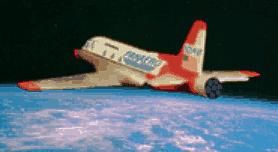
Home - Search - Browse - Alphabetic Index: 0- 1- 2- 3- 4- 5- 6- 7- 8- 9
A- B- C- D- E- F- G- H- I- J- K- L- M- N- O- P- Q- R- S- T- U- V- W- X- Y- Z
SabreRocket
 SabreRpcket |
Status: Study 2004. Thrust: 146.77 kN (32,994 lbf).
SabreRocket was designed by Len Cormier of Panaero, Fairfax, Virginia. The SabreRocket would takeoff and land from any conventional airfield, and achieve a 100 km altitude with a single stage system, using a modified Sabre-40 business jet. The jet would be equipped with seven (7) Microcosm engines. Vacuum thrust with the existing nozzles was 2138 kgf per engine, providing an initial thrust-to-weight ratio of about 1.5:1 when all of the rocket engines were ignited. From an altitude of 55 km and a speed of Mach 2.97, it would take the SabreRocket approximately 100 seconds to coast past the 100-km altitude limit at a speed of approximately Mach 0.4. The vehicle reached the apogee of its flight at an altitude of 102 km and then began a free fall descent. For approximately another 80 seconds, the SabreRocket descended unpowered. The total time the crew and passengers experienced weightless was approximately 180 seconds. Using the attitude control system, the pilot re-entered the atmosphere at an 85 or 90 degree flight-path angle and an angle-of-attack of 70 degrees. In this attitude, the wings act as a parachute or drag brake. This technique was to minimize Mach number on re-entry in order to minimize G-load and heating.
Family: Spaceplane, Suborbital. Country: USA. Agency: Panaero.
Back to top of page
Home - Search - Browse - Alphabetic Index: 0- 1- 2- 3- 4- 5- 6- 7- 8- 9
A- B- C- D- E- F- G- H- I- J- K- L- M- N- O- P- Q- R- S- T- U- V- W- X- Y- Z
© 1997-2019 Mark Wade - Contact
© / Conditions for Use